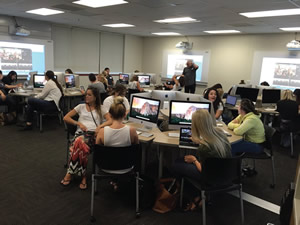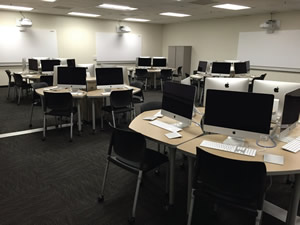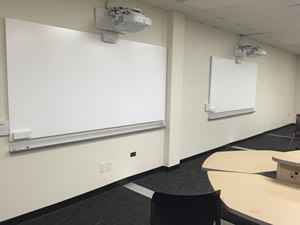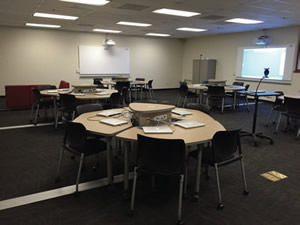Teaching the Teachers
- By Otto Benavides
- 05/01/17

PHOTO COURTESY OF CSU FRESNO
In a very short time, today’s college students will likely be the ones designing the technologies of the future. They will be the engineers, teachers, entrepreneurs and artists who will ultimately create the next wave of self-driving vehicles, the newest virtual-reality platforms for learning, and new solutions in everything from medicine to mobile technology. But how quickly they can do this and how well prepared they are is up to those of us teaching them today. The higher education community must provide the right environment — and the right technology — to promote next-generation learning.
How to Foster Next-Generation Learning
First, let’s discuss what next-generation learning is. Next-generation learning involves teaching students the skills they will need to navigate the ever-changing needs and technologies of the future.
Universities are tasked with preparing future employees to problem solve, work in teams and share ideas. Because of this, there is a movement toward changing classroom environments to foster these skills. Universities are increasingly creating active learning environments that incorporate technology tools to allow students to work together to solve current
and future problems.
The 2017 NMC Horizon Report for Higher Education (cdn.nmc.org) discusses this shift. It describes the key trends driving higher education technology. These include a growing emphasis on:
- Deeper learning approaches — or approaches that engage a student in critical thinking, problem-solving, collaboration and self-directed learning. Among these approaches is project-based learning which fosters a student-centered, active learning environment. This, according to the report, is needed to motivate students and help them make clear connections to the real world.
- Redesigning learning spaces. More and more universities are rearranging their physical classrooms to create a more active learning environment. These learning spaces are flexible with large displays and with wireless capabilities for multiple devices. They’re designed to facilitate project-based interactions rather than lecture-based programming.
- Collaborative learning approaches in which students work together in peer-to-peer group activities that place the student at the center of learning and emphasize interaction, group work and developing solutions to real challenges.
Colleges and universities that can successfully do these things will be well on their way to ensuring their students have next generation learning skills.
Using Technology to Build a Collaborative Learning Environment

PHOTOS COURTESY OF CSU FRESNO
LEARNING IN THE ROUND. In California State University at Fresno’s Collaborative Classrooms, students are the stars. The classrooms were designed to have students at the center of instruction, with the help of five separate pods, 30 computers, six display devices, Apple TVs, and five projectors. The instructor has access to the projection devices as well — to the computer assigned to the teacher, and the flat display at the front of the room. The design of the space puts students at the center of instruction, shifting the faculty role to one of tutor or guide.
What sort of technology is needed to promote next-generation learning? It can essentially be any technology that creates these collaborative, active, student-centered learning environments. One real-world example is the Collaborative Classrooms initiative at California State University (CSU) Fresno.
CSU Fresno’s School of Education developed the initiative to create a more active learning environment for students and help its future teachers become more accustomed to using technology in support of learning. It overhauled and redesigned the spaces and outfitted them with technology that would create a collaborative, active, student-centered learning environment.
The classrooms exemplify the trends described in the Horizon Report. CSU Fresno replaced the lecture-style setup — in which rows of desks face the front of the room — with pods of desks that are easily rearranged to allow students to work more easily in groups. Instead of a podium or desk at the front of the room, the instructor uses a rolling table with a Bluetooth keyboard and trackpad or mobile device so he or she can move around the classroom and act as a coach for project-based learning.

PHOTO COURTESY OF CSU FRESNO
Each pod of desks is outfitted with an Epson interactive projector and screen-sharing software so that students can access and project content directly from their own devices during group work. They can also use the touch-enabled interactive displays to easily collaborate and share their work with each other and the entire class. We found this interactivity, and the ability for students to actually make notes with their fingers directly onto the image that is projected onto the wall, encourages participation and improves engagement.
Students can use shared drives to compile research, edit documents, build presentations and even create movies — the classrooms are equipped with video cameras, green screens and cinema lights.
Instead of the old model, in which students listened to the lecture and took notes, the technology and design of the Collaborative Classrooms encourages project-based, active learning.

PHOTO COURTESY OF CSU FRESNO
For example, if the instructor is teaching a lesson on the Constitution, he or she might start a discussion with students on who wrote the Constitution, what it is about, why it was created, and how it affects life today. In a traditional lecture hall, the instructor might give this information to the students, and the students would take notes and memorize facts and perhaps ask questions. In a collaborative learning environment, the students do the research themselves. They work in teams to conduct online research, create a report about what they’ve learned and then use the presentation displays to present their findings to the class. This could be done with any subject — from statistics to art. The instructor acts as a guide and puts students in charge of their own learning. Using collaborative learning environments with the proper design and technology is a much better way to engage students than the traditional lecture style. Students not only learn the material, they also gain experience using the latest technology and presentation displays and they gain the next-generation skills — such as teamwork, collaboration, critical thinking and presentation skills — that they will need to have in order to succeed in future careers.
CSU Fresno’s first Collaborative Classroom opened in 2012 and was such a success that the School of Education decided to add two more in 2015. The classrooms have been extremely popular and are consistently booked. Faculty members say this initiative has truly improved student learning and it has helped model what future elementary and secondary school teachers will do in the classroom.
Looking Toward the Future
In order for universities to promote next-generation learning, they must always be forward thinking. They must reimagine their learning spaces, always be on the lookout for the best interactive technologies and constantly watch for ways to promote collaboration, project work and active learning among students.
It is also important to budget for technology upgrades and to provide professional development for the instructors. Colleges and universities should look for ways to use technology to improve teaching and learning. For example, perhaps in 10 years’ time I might be teaching a class in another country and I will be projected as a hologram who can walk around the room and see what students are working on. The sky is the limit. Universities must embrace collaborative technology in order to offer game-changing results for students and in order to truly embrace next-generation learning.
This article originally appeared in the issue of .